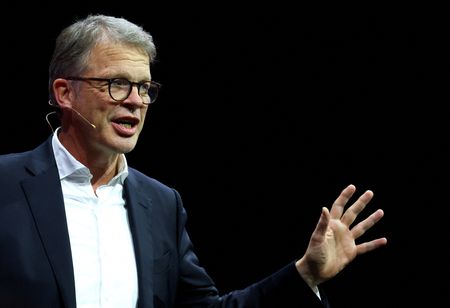By Tom Sims and Matthias Inverardi
FRANKFURT (Reuters) -Deutsche Bank on Monday unveiled new profit and revenue targets for the next three years as Germany’s largest lender tries to convince investors that its years-long recovery remains on course and it can compete with Wall Street titans.
The slew of targets for 2028 is the third major programme under CEO Christian Sewing, who took the helm as the bank was teetering after years of losses.
Sewing has stabilized the bank, returning it to consistent profit, but some investors criticise Deutsche Bank for overreliance on its global investment bank and weakness at the retail division.
Deutsche is now in the final stretch of its current three-year plan. Most analysts believe it will meet its goals.
“We are going from defence to offence,” Sewing told investors.
Among key elements of the plan unveiled on Monday, Deutsche Bank is aiming for so-called return on tangible equity – an important profit metric – of more than 13% by 2028, up from the current goal of more than 10%. That is in line with BNP Paribas’ 2028 target but less than UBS’s 18%.
Deutsche Bank wants to increase revenue to around 37 billion euros ($42.91 billion) in 2028, up from around 32 billion in 2025.
It is also striving for a cost-to-income ratio of below 60% by 2028, down from its current target of below 65%.
“Our long-term vision is to be the European champion,” Sewing said.
JPMorgan analysts called the announcements “a positive event with ambitious targets”.
Deutsche Bank’s shares, however, were down 3% by late afternoon, outpacing a decline in European banks.
In its expansion push, Deutsche said it would hire more than 60 senior investment bankers who advise on sectors that include healthcare and technology.
The bank unveiled its last three-year plan in 2022, just weeks into the Ukraine war, a period of great uncertainty that resulted in an energy crunch and soaring inflation but also in higher interest rates that fed bank profits.
These days, bankers and regulators say uncertainty remains high due to a global trade war, credit risks, high debt levels, artificial intelligence and a slumping domestic economy.
The latest plan is less sweeping than Sewing’s first big strategy overhaul in 2019, which downsized the investment bank, focused on corporate clients and promised to slash 18,000 jobs, though in the end the bank did not cut that many as business picked up again.
In 2022, Sewing’s second plan included targets through the end of this year. The bank is on track to meet them, though Deutsche did dump its original and more ambitious cost-to-income target as the bank said it wanted to invest in growth, rather than keep paring.
Hans-Peter Burghof, a banking expert at Germany’s University of Hohenheim, said Deutsche Bank had become more diversified and its culture less dominated by a “mercenary-style” investment bank.
“However, banking in Germany remains difficult. Regulation is still a nightmare, and there is far more competition than in many other countries,” he said.
Despite the bank’s recovery, investors have remained nervous at times. That was the case in 2023, when Deutsche shares dropped 15% in a single day after banks had to be rescued in the United States and in Switzerland.
The turmoil prompted a rare intervention by Germany’s then Chancellor Olaf Scholz, who said: “There’s no reason to worry.”
($1 = 0.8624 euros)
(Reporting by Tom Sims and Matthias Inverardi; additional reporting by Tommy Reggiori Wilkes; Editing by Miranda Murray, Chizu Nomiyama and Susan Fenton)











